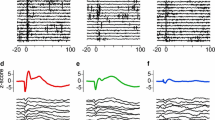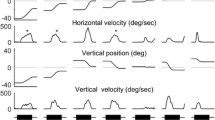Summary
-
1.
The “corpus callosum cat” is a pretrigeminal preparation in which the brain has been split in the midline exempting the corpus callosum. Consequently, cortical potentials evoked by activation of the contralateral hemisphere are transcallosal potentials (tcp).
-
2.
Tcp were recorded from the somesthetic cortex, the gyrus suprasylvius and the visual cortex after stimulation of the contralateral nucleus ventralis posterolateralis, the nucleus lateralis posterior and the corpus geniculatum laterale and compared with the corresponding primary evoked potentials (pep) of the other side.
-
3.
Tcp under these conditions are monophasic, surface-negative deflections of 2–5 ms latency and 15–25 ms duration. They may be followed, as are the pep, by a surface-positive wave of 150–200 ms duration inducing cortical 10/sec spindle activity.
-
4.
Tcp and pep show different reactions to modifications of cortical excitability and during interactions. In contrast to the pep, the dipoles of the tcp cannot be correlated with the laminar organization of the cortex.
-
5.
Extracellular unit recording from the cortex revealed short latency activation by primary thalamocortical volleys, but very seldom by transcallosal ones. In contrary, longlasting inhibition of spontaneous activity was induced by both transcallosal and primary volleys. The duration of the inhibition could be correlated with the duration of the positive potential following either tcp or pep.
-
6.
During cortical 10/sec spindle activity, 13% of the neurons were inhibited and 51% activated, regardless of whether the spindle was elicited by primary or transcallosal volleys or whether it occurred spontaneously.
-
7.
The results of this investigation are compared with previous reports and are discussed with regard to a neurophysiological substrate of the interhemispheric transfer of information.
Summary
-
1.
Die Corpus Callosum-Katze ist ein prätrigeminales Präparat, bei dem die Mittellinie des Hirns mit Ausnahme des Balkens durchtrennt wurde. Corticale Potentiale, die nach Erregung der gegenseitigen Hemisphäre evoziert werden, sind somit zwangsläufig transcallosale Potentiale (tcP).
-
2.
tcP wurden vom somatischen Cortex, vom Gyrus suprasylvius und vom visuellen Cortex nach Reizung des gegenseitigen Nucleus lateralis posterior, des Nucleus ventralis posterolateralis und des Corpus geniculatum abgeleitet und mit den primären evozierten Potentialen (peP) der Gegenseite verglichen.
-
3.
Die tcP stellen sich unabhängig vom Ableitungsort als monophasisch oberflächennegative Potentiale mit einer Latenz von 2–5 ms und einer Dauer von 15–25 ms dar. Den tcP kann ebenso wie den korrespondierenden peP ein oberflächenpositives Potential von 150–200 ms Dauer folgen, das in eine corticale 10/sec-Spindel überführt.
-
4.
tcP und peP werden durch Modifikationen der corticalen Erregbarkeit und im Verlauf von Interaktionen unterschiedlich beeinflußt. Die den tcP zugrundeliegenden Dipole können im Gegensatz zu den peP nicht mit der anatomisch laminären Organisation des Cortex korreliert werden.
-
5.
Transcallosale Afferenzen führen im Gegensatz zu den primären thalamocorticalen Afferenzen nur in seltenen Fällen zu kurzlatenten Aktivationen von corticalen Neuronen. Langdauernde Inhibitionen der Spontanaktivität werden dagegen in etwa gleicher Häufigkeit durch primäre und transcallosale Afferenzen induziert. Die Dauer der Inhibition kann mit der Dauer der den peP und tcP folgenden positiven Potentiale korreliert werden.
-
6.
Während einer corticalen Spindel werden 13% der Zellen inhibiert und 51% aktiviert unabhängig davon, ob die Spindel durch ein tcP oder peP induziert wird oder spontan auftritt.
-
7.
Die vorliegenden Resultate werden mit früheren Untersuchungen verglichen und im Hinblick auf ein neurophysiologisches Substrat des interhemisphärischen Informationstransfers diskutiert.
Similar content being viewed by others
Literatur
Adrian, E. D.: Afferent discharges to the cerebral cortex from peripheral sense organs. J. Physiol. (Lond.) 100, 159–191 (1941).
Ajmone Marsan, C., and E. Laskowski: Callosal effects and excitability changes in the human epileptic cortex. Electroenceph. clin. Neurophysiol. 14, 305–319 (1962).
—, and A. Morillo: Cortical control and callosal mechanisms in the visual system of cat. Electroenceph. clin. Neurophysiol. 13, 553–563 (1961).
— Callosal and specific response in the visual cortex of the cat. Arch. ital. Biol. 101, 1–29 (1963).
Andersen, P., J. C. Eccles, and T. A. Sears: The ventro-basal complex of the thalamus: types of cells, their responses and their functional organization. J. Physiol. (Lond.) 174, 370–399 (1964).
Biemond, A.: Experimentell-anatomische Untersuchungen über die corticofugalen optischen Verbindungen bei Kaninchen und Affen. Z. ges. Neurol. Psychiat. 129, 65–127 (1930).
Bishop, G. H., and J. L. O'Leary: The effect of polarizing currents on cell potentials and their significance in the interpretation of central nervous activity. Electroenceph. clin. Neurophysiol. 2, 401–416 (1950).
Bremer, F.: Analogie remarquable des résponses sensorielles et callosales dans l'aire visuelle du chat. Arch. int. Physiol. 63, 233–237 (1955).
— Physiology of the corpus callosum. Res. Publ. Ass. nerv. ment. Dis. 36, 424–448 (1958).
— Role of the corpus callosum in interhemispheric integration. Electroenceph. clin. Neurophysiol. 11, 371–372 (1959).
— L'interprétation des potentiels électriques de l'écorce cérébrale. In: Structure and Function of the Cerebral Cortex. Amsterdam: Elsevier Publ. Comp. 1960.
— Etude électrographique d'un transfert callosal. Arch. ital. Biol. 104, 1–29 (1966).
— et C. Terzuolo: Transfert interhémisphérique d'informations sensorielles par le corps calleux. J. Physiol. (Lond.) 47, 105–107 (1955).
Bures, J., and O. Buresova: The use of Leaos spreading depression in the study of interhemispheric transfer of memory traces. J. comp. Physiol. Psychol. 53, 558–563 (1960).
Calvet, J., M. C. Calvet et J. Scherrer: Etude stratographique corticale de l'activité spontanée. Electroenceph. clin. Neurophysiol. 17, 109–125 (1964).
Chang, H. T.: Cortical response to activity of callosal neurons. J. Neurophysiol. 16, 117–132 (1953a).
— Interaction of evoked cortical potentials. J. Neurophysiol. 16, 133–144 (1953b).
Clare, M. H., W. M. Landau, and G. H. Bishop: The cortical response to direct stimulation of the corpus callosum in the cat. Electroenceph. clin. Neurophysiol. 13, 21–33 (1961).
Creutzfeld, O., u. G. Struck: Neurophysiologie und Morphologie der chronisch isolierten Cortexinsel der Katze: Hirnpotentiale und Neuronentätigkeit einer isolierten Nervenzellpopulation ohne afferente Fasern. Arch. Psychiat. Nervenkr. 203, 708–731 (1962).
Curtis, H. J.: Intercortical connections of corpus callosum as indicated by evoked potentials. J. Neurophysiol. 3, 405–413 (1940).
Denny, D., and J. M. Brookhart: The effects of applied polarization on evoked electrocortical waves in the cat. Electroenceph. clin. Neurophysiol. 14, 885–897 (1962).
Eidelberg, E.: Callosal and non-callosal connexions between the sensorimotor cortices in cat and monkey. Electroenceph. clin. Neurophysiol. (in press).
Euler, C., and G. F. Ricci: Cortical evoked responses in auditory area and significance of apical dendrites. J. Neurophysiol. 21, 231–246 (1958).
Feng, T., and S. Fan: Cortical response to antidromic stimulation of the corpus callosum. Scientia Sinica 6, 159–168 (1957).
Geschwind, M.: Disconnexion syndromes in animals and man. Brain 88, 237–294 and 585–644 (1965).
Heimer, L., F. F. Ebner, and W. J. H. Nauta: A note on the termination of commisural fibers in the neocortex. Brain Res. 5, 171–177 (1967).
Hossman, K.-A.: Midline section of the cat brain with sparing of the corpus callosum. Electroenceph. clin. Neurophysiol. (in press).
Landau, W. M., G. H. Bishop, and M. H. Clare: The interaction of several varieties of evoked response in visual and association cortex of the cat. Electroenceph. clin. Neurophysiol. 13, 43–53 (1961).
— Analysis of the form and distribution of evoked cortical potentials under the influence of polarizing currents. J. Neurophysiol. 27, 788–813 (1964).
Latimer, C. N., and T. T. Kennedy: Cortical unit activity following transcallosal volleys. J. Neurophysiol. 24, 66–79 (1961).
Leao, A. A. P.: Spreading depression of activity in the cerebral cortex. J. Neurophysiol. 7, 359–396 (1944).
Li, C. L., and H. Jasper: Microelectrode studies of electric activity of cerebral cortex in cat. J. Physiol. (Lond.) 121, 117–140 (1953).
Lorente de No, R.: La corteza cerebral del raton. Trab. Lab. Invest. Biol. Univ. Madrid 20, 41–78 (1922).
McCulloch, W. S.: Cortico-cortical connections. In: C. P. Bucy. The precentral motor cortex, pp. 212–242. Urbana: Univ. of Illinois Press 1944.
Myers, R. E.: Interocular transfer of pattern discrimination in cats following section of crossed optic fibers. J. comp. Physiol. Psychol. 48, 470–472 (1955).
— Function of corpus callosum in interocular transfer. Brain 79, 358–363 (1956).
— Corpus callosum and interhemispheric communication: enduring memory effects. Fed. Proc. 16, 92 (1957).
Nauta, W. J. H., and V. M. Bucher: Efferent connections of the striate cortex in the albino rat. J. comp. Neurol. 100, 257–286 (1954).
Perl, E. R., and D. G. Whitlock: Interaction of potentials evoked by thalamic and contralateral cortical stimulation in the somato-sensory area of the cerebrum. Fed. Proc. 13, 110 (1954).
Perl, E. R., and D. G. Whitlock: Potentials evoked in cerebral somatosensory region. J. Neurophysiol. 18, 486–501 (1955).
Poljak, S.: An experimental study of the association callosal, and projection fibers of the cerebral cortex of the cat. J. comp. Neurol. 44, 197–258 (1927).
Purpura, D. P., and J. G. McMurty: Intracellular activities and evoked potential changes during polarization of motor cortex. J. Neurophysiol. 28, 165–185 (1965).
Valkenburg, C. T., van: Experimental and pathologico-anatomical researches on the corpus callosum. Brain 36, 119–165 (1913).
Villaverde, J. M., de: Les connexions commisurales des régions postérieures du cerveau du lapin. Trab. Lab. Invest. Biol. Univ. Madrid 22, 99–141 (1924).
— Sur la termaison des fibres calleuses dans l'écorce cérébrale. Trab. Lab. Invest. Biol. Univ. Madrid 27, 275–297 (1932a).
— Quelques détails sur la manière dont les fibres calleuses se distribuent dans l'écorce cérébrale. Trab. Lab. Invest. Biol. Univ. Madrid 27, 345–375 (1932b).
— Contribution à la connaissance du système commisural de l'écorce motrice de la chauve-souris. Trab. Lab. Invest. Biol. Univ. Madrid 28, 75–101 (1932c).
Author information
Authors and Affiliations
Rights and permissions
About this article
Cite this article
Hossmann, K.A. Untersuchungen über transcallosale Potentiale an der akuten Corpus Callosum-Katze. Deutsche Zeitschrift f. Nervenheilkunde 195, 79–102 (1969). https://doi.org/10.1007/BF00244193
Received:
Issue Date:
DOI: https://doi.org/10.1007/BF00244193




